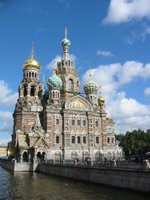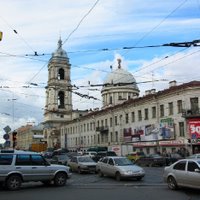FLASHBACK #57: St. Petersburg With The Swedish Finn
 Back in 2004, Silja Lines were doing overnight cruises to St. Petersburg from Helsinki. I had always wanted to visit Russia, which shares a 1300km border – and a turbulent history - with Finland, so I asked my Swedish-speaking Finnish friend to come with me. Without hesitating, we applied for our visas, bought our tickets and boarded the cruise liner on a reasonably bright afternoon in mid-September. I was surprised how empty the boat was; quite clearly, St. Petersburg was not a popular destination or had passengers heard about our reservation and cancelled?! Regardless, the boat departed and Helsinki blended into the distance.
Back in 2004, Silja Lines were doing overnight cruises to St. Petersburg from Helsinki. I had always wanted to visit Russia, which shares a 1300km border – and a turbulent history - with Finland, so I asked my Swedish-speaking Finnish friend to come with me. Without hesitating, we applied for our visas, bought our tickets and boarded the cruise liner on a reasonably bright afternoon in mid-September. I was surprised how empty the boat was; quite clearly, St. Petersburg was not a popular destination or had passengers heard about our reservation and cancelled?! Regardless, the boat departed and Helsinki blended into the distance.We docked at St. Petersburg's Maritime Passenger Terminal bright and early the next morning, but we had no rush; taking our time, we ate breakfast onboard before the long walk into town. We had two nights accommodation onboard and, whilst bitterly windy, we wandered around the city, soaking up its visual delights all of which had a story to tell. Dubbed the Venice of the North because of its palace-lined canals, St. Petersburg covers an area of 600 sq km (235 sq miles) and is home to 4.2 million Russians.
 Alexandr of Novgorod defeated the Swedes near the mouth of the River Neva in 1240, earning the title Nevsky (of the Neva). When Sweden regained control in the 17th century, it was Peter the Great's desire to crush this rival and make Russia a European power which, eventually, led to the founding of St Petersburg.
Alexandr of Novgorod defeated the Swedes near the mouth of the River Neva in 1240, earning the title Nevsky (of the Neva). When Sweden regained control in the 17th century, it was Peter the Great's desire to crush this rival and make Russia a European power which, eventually, led to the founding of St Petersburg.
At the start of the Great Northern War (1700-21), Peter the Great captured the Swedish outposts on the Neva, and in 1703, founded the Peter & Paul Fortress on the Neva a few kilometers in from the sea. In 1712, St. Petersburg became the capital of Russia, forcing administrators, nobles and merchants to move here and build new homes. Peasants were drafted in, while architects and artisans were brought from all over Europe.
By the time of Peter the Great’s death in 1725, St. Petersburg had a huge population and 90% of Russia's foreign trade passed through it. Peter's immediate successors moved the capital back to Moscow, but Empress Anna Ivanovna (1730-40) returned it to St Petersburg. Between 1741 and 1825, under Empress Elizabeth, Catherine the Great and Alexander I, it became a cosmopolitan city with a royal court of renown. These monarchs commissioned a series of dazzling palaces, government buildings and churches, which turned it into one of Europe's grandest capitals. Industrialisation, which peaked in the 1890s, brought a flood of poor workers into the city, leading to overcrowding, poor sanitation and epidemics leading to widespread discontent.

 St Petersburg became host of endless strikes and political violence and was the site of the revolution that would go down in the history books as Bloody Sunday (9 January 1905); a strikers' march to petition the tsar at the Winter Palace was fired on by troops. Again, in 1917, St. Petersburg saw the start of the Russian Revolution. It was here that workers' protests turned into a general strike and troops mutinied, bringing about the end of the monarchy.
St Petersburg became host of endless strikes and political violence and was the site of the revolution that would go down in the history books as Bloody Sunday (9 January 1905); a strikers' march to petition the tsar at the Winter Palace was fired on by troops. Again, in 1917, St. Petersburg saw the start of the Russian Revolution. It was here that workers' protests turned into a general strike and troops mutinied, bringing about the end of the monarchy.
It was to St. Petersburg that Lenin travelled in April 1917 to organise the Bolshevik Party. The actual revolution came after Bolsheviks occupied key positions in St. Petersburg on 24 October. The new government operated from here until March 1918, when it moved to Moscow, fearing a German attack. The city was renamed Leningrad after Lenin's death in 1924 and became the site of Stalin's 1930s industrialisation programme. By 1939, the city had 3 million people providing 11% of Soviet industrial output.
When the Germans attacked the USSR in June 1941, it took them only two-and-a-half months to reach Leningrad. Hitler hated the place and swore to wipe it from the face of the earth; up to a million died from shelling, starvation and disease. After the war, Leningrad was reconstructed and reborn, though it took until 1960 for its population to exceed pre-WWII levels.
In 1991, the Soviet Union was officially proclaimed 'dead' and residents of Leningrad voted to rename the city St Petersburg. Since then, the city has tried to re-establish itself as Russia's window on the West, amidst economic and crime problems.
 We had two nights accommodation onboard Silja Opera and, during that time, we ambled along the River Neva, visiting Nevsky Prospekt, a commercial road that stretches four kilometers to the south of the city.
We had two nights accommodation onboard Silja Opera and, during that time, we ambled along the River Neva, visiting Nevsky Prospekt, a commercial road that stretches four kilometers to the south of the city.
Sites-wise, we visited the half kilometre block of Palace Square, which features the Winter Palace, home to the tsars from 1762 to 1917, and the impressive State Hermitage Museum. We spent many hours wandering through the countless corridors of the Hermitage. I was thankful for the map otherwise we would still be working out how to find the exit!




 We visited the nearby St Isaac's Cathedral, which took more than forty years to build. With a golden dome that dominates the St. Petersburg skyline, the cathedral finally opened in 1858. The granite of the structure was sourced from Finland, delivered using specially built ships and railways. We climbed the 43m-high colonnade for breathtaking views of the city.
We visited the nearby St Isaac's Cathedral, which took more than forty years to build. With a golden dome that dominates the St. Petersburg skyline, the cathedral finally opened in 1858. The granite of the structure was sourced from Finland, delivered using specially built ships and railways. We climbed the 43m-high colonnade for breathtaking views of the city.



 We also visited the Peter & Paul Fortress, the oldest building in town, which is home to many of Russia's Romanov rulers who were buried here. More recently, dowager empress Maria Fyodorovna, the mother of the last tsar, Nicholas II, was buried alongside her husband, Alexander III, in September 2006, 78 years after her death. Interestingly, the empress, Danish by birth, was rescued by her nephew, King George V of England, in 1919 following the Bolshevik Revolution.
We also visited the Peter & Paul Fortress, the oldest building in town, which is home to many of Russia's Romanov rulers who were buried here. More recently, dowager empress Maria Fyodorovna, the mother of the last tsar, Nicholas II, was buried alongside her husband, Alexander III, in September 2006, 78 years after her death. Interestingly, the empress, Danish by birth, was rescued by her nephew, King George V of England, in 1919 following the Bolshevik Revolution.
As we made our way back to the boat at the end of each day, we passed statues of Dostoevsky, the famous 19th Century author who wrote Crime & Punishment, and Lenin. We passed ornate squares, replete with fountains set admist a backdrop of warn-out looking, but eye-pleasing buildings. St. Petersburg truly was a mish-mash of old and new as it constantly struggles to keep everything in order.


 One afternoon, we made our way back to the boat via the district of Vasilyevski where we got a taste of the real Russia, very different from the cleaner, better maintained districts south of the River Neva. In a cafe, I got talking to a waitress who spoke very good English; she explained that she has a penpal in Scotland and likes to meet new people. I asked what life was like in St. Petersburg, pointing out of the window at the crowds rushing past in the street. Smiling, relief on her face, she said life was much better than even before for people living in St. Petersburg.
One afternoon, we made our way back to the boat via the district of Vasilyevski where we got a taste of the real Russia, very different from the cleaner, better maintained districts south of the River Neva. In a cafe, I got talking to a waitress who spoke very good English; she explained that she has a penpal in Scotland and likes to meet new people. I asked what life was like in St. Petersburg, pointing out of the window at the crowds rushing past in the street. Smiling, relief on her face, she said life was much better than even before for people living in St. Petersburg. As we made our way back to the boat one last time, we noticed how, throughout our trip, the smell of petrol – a result of pollution and using impure petrol - was ever prevalent. When the ship left the harbour, I felt a sense of relief. While I had never felt threatened whilst visiting St. Petersburg, Russia still has a lot to do to persuade the West in its intentions. Onboard that evening, the Swedish Finn and I partied. Although there were next to no people onboard, we made the most of it.
As we made our way back to the boat one last time, we noticed how, throughout our trip, the smell of petrol – a result of pollution and using impure petrol - was ever prevalent. When the ship left the harbour, I felt a sense of relief. While I had never felt threatened whilst visiting St. Petersburg, Russia still has a lot to do to persuade the West in its intentions. Onboard that evening, the Swedish Finn and I partied. Although there were next to no people onboard, we made the most of it.


<< Home